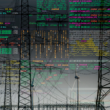DOE $70M grid security and resilience funding targets cybersecurity, wildfires, other risks
Dive Brief:
- The U.S. Department of Energy on Thursday announced it will make up to $70 million available to public and private sector stakeholders, universities and the national laboratory system, to research new security and resilience technologies for the U.S. power sector.
- The funding opportunity will be managed by DOE’s Cybersecurity, Energy Security, and Emergency Response office and is “intentionally broad,” the agency said.
- CESER anticipates funding up to 25 research, development and demonstration projects, with awards ranging from $500,000 to $5 million. Suggested topic areas include cybersecurity, wildfire mitigation, physical security and climate research.
Dive Insight:
DOE enters 2024 looking to protect “all types of energy delivery infrastructure” from a growing array of threats. The new funding will focus on innovative and unique solutions that are not “one size fits all,” the agency said.
“Making smart investments in America’s energy systems today is essential to ensuring they’re more reliable and resilient against tomorrow’s threats,” Secretary of Energy Jennifer Granholm said in a statement. “These investments will help save money in the long run by identifying and developing innovative solutions.”
Responses to the funding opportunity must support a more secure and reliable energy system through “targeted improvements” to electricity generation, transmission or distribution, including renewables, energy management systems, and electric vehicles; and oil and natural gas production, refining, storage, or distribution, DOE said.
A growing number of hackers are developing capabilities to disrupt energy infrastructure in North America, according to a report security firm Dragos published last year. The increasingly-distributed nature of the grid resources means more potential targets, but the report also concluded the energy sector is relatively well-defended.
“Electric utilities showed the best preparedness, followed by oil and gas,” Dragos said. “Manufacturing represented the worst results among verticals.”
To read the complete article, visit Utility Dive.

















